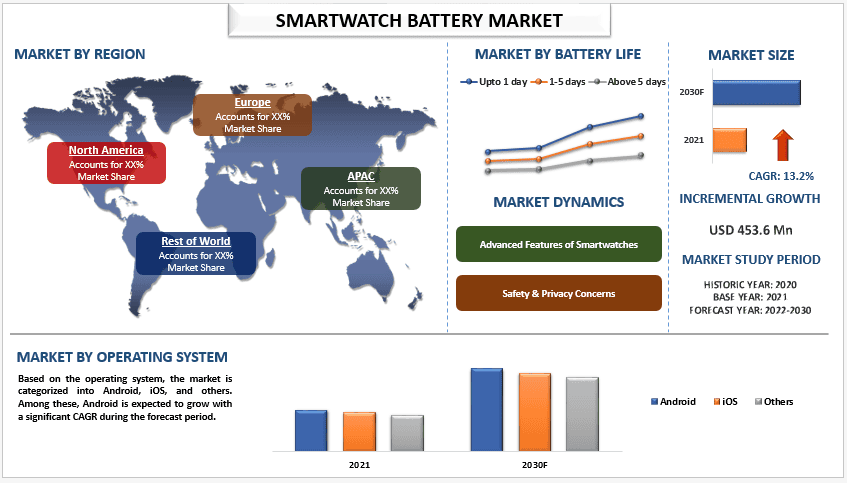Smartwatch Battery Market Size, Growth, Trends, Analysis and Forecast to 2030

The smartwatch battery—the rechargeable energy source that powers a smartwatch’s diverse features—is playing an increasingly important role in the global wearable technology market. More than just timekeeping devices, smartwatches today support fitness tracking, health monitoring, notifications, and a wide range of apps. These functionalities depend heavily on reliable, compact, and long-lasting batteries.
According to UnivDatos, the global smartwatch battery market was valued at USD 453.6 million in 2021 and is projected to grow at a CAGR of 13.2% from 2023 to 2030, reaching multi-billion-dollar revenues by the end of the forecast period.
Why Batteries Matter in Smartwatches
Smartwatch batteries are designed to be small, lightweight, yet powerful enough to sustain displays, sensors, processors, and wireless connectivity modules such as Bluetooth, Wi-Fi, and in some cases, cellular radios. Despite their size, these batteries enable continuous operation of health monitoring features, notifications, and apps.
Battery life varies significantly depending on the device’s features, screen type, processor efficiency, and software optimization. While some watches can last several days, others may need daily charging.
Manufacturers are adopting energy-efficient designs, smart power management strategies, and advanced software optimization to extend battery life and meet user expectations for convenience.
Market Growth Drivers
- Rising Consumer Demand for Wearables – Growing interest in fitness, wellness, and connected lifestyles is driving smartwatch adoption globally.
- Income Growth & Tech-Savvy Population – Higher disposable incomes allow consumers to invest in advanced gadgets.
- Battery Technology Advancements – Developments in lithium-ion (Li-ion) batteries, higher energy density, improved efficiency, and faster charging are transforming smartwatch performance.
- Health & Fitness Awareness – Increasing awareness of physical and mental well-being is pushing demand for health-focused features.
Access sample report (including graphs, charts, and figures): https://univdatos.com/reports/smartwatch-battery-market?popup=report-enquiry
Fitness & Health Monitoring: A Key Growth Catalyst
Fitness tracking has emerged as a core feature of smartwatches. Leading brands like Apple, Samsung, Fitbit, Fossil, and Noise are incorporating advanced health-monitoring tools, such as:
- Electrocardiograms (ECG)
- Blood oxygen (SpO2) monitoring
- Stress monitoring
- Calorie tracking
- Sleep tracking
For example, Apple’s Series 7 smartwatch, launched in 2021, includes enhanced fall detection, ECG sensors, sleep tracking, and blood oxygen monitoring, reflecting consumer demand for health-driven innovation.
Battery Technology & Consumer Expectations
Lithium-ion (Li-ion) batteries remain the standard in most smartwatches due to their compact size and efficiency. However, all rechargeable batteries lose capacity over time. To extend battery life, experts recommend:
- Avoiding cheap or fast chargers that can damage the battery.
- Not using the device during charging.
- Charging in moderate temperatures.
- Recharging before the battery drops below 5%.
- Avoiding complete battery drain.
Research is also underway to improve battery longevity and performance. Notably:
- Flexible Display Corp. developed a stretchable battery with a seven-day capacity.
- The University of California, San Diego created a graphene-anode and lithium-metal cathode battery with 50% longer life than conventional Li-ion cells.
Regional Insights: The U.S. Leads Adoption
The United States holds a significant share of the smartwatch battery market, fueled by consumer demand for convenience and long-lasting devices.
Key statistics highlighting U.S. adoption:
- Wearable usage grew from 9% to 33% in just four years (as of 2021).
- 58% of U.S. households own a smartwatch or fitness tracker.
- 39% of Americans personally own a smartwatch or fitness tracker.
- Around 14% purchased devices post-COVID, with fitness tracking and health monitoring being top uses.
- The U.S. wearable tech audience is approximately 24.1 million people, with a 50:50 gender split, predominantly aged 25–44 years, and largely from high-income households.
Conclusion
The smartwatch battery market is witnessing rapid growth, powered by advancements in lithium-ion technology, rising consumer health awareness, and increasing demand for smart and connected devices. With global adoption expanding and manufacturers innovating for longer battery life, smaller designs, and improved efficiency, the sector is set for substantial expansion.
As wearable adoption accelerates—particularly in health-conscious and tech-savvy markets like the U.S.—battery innovation will remain a cornerstone of competitive differentiation in the smartwatch industry.
Contact Us:
Email - contact@univdatos.com
Website - www.univdatos.com
- Art
- Causes
- Crafts
- Dance
- Drinks
- Film
- Fitness
- Food
- Games
- Gardening
- Health
- Home
- Literature
- Music
- Networking
- Other
- Party
- Religion
- Shopping
- Sports
- Theater
- Wellness

